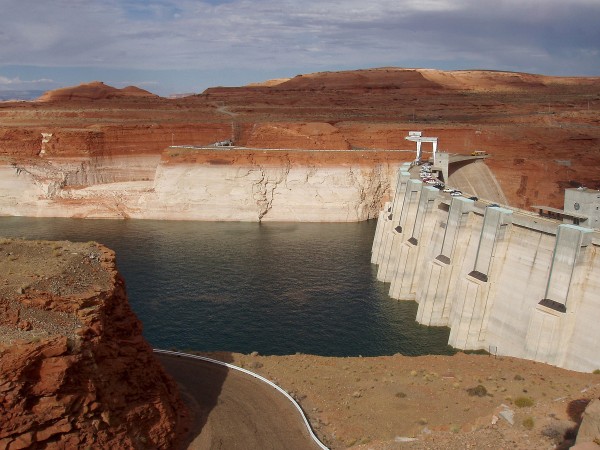
The U.S. Bureau of Reclamation announced today it will reduce the flow out of Glen Canyon Dam by 9% starting in October. Homeowners and farmers will still get the same amount as they do now, but the decision highlights the likelihood of future shortages. "I view this as another serious warning to users of the Colorado River that we're headed for big trouble," says water and climate specialist Peter Gleick of the Pacific Water Institute in Oakland, California.
Historically, the untamed Colorado River flooded after the snow melted in the Rocky Mountains and then water levels dropped during the summer. Two massive dams changed that behavior, regulating the river throughout the year and also generating billions of kilowatts of electricity. Glen Canyon Dam in northern Arizona created the vast Lake Powell in 1966. And more than 575 kilometers downstream, Hoover Dam, completed in 1936, heads up a reservoir called Lake Mead near Las Vegas, Nevada.
According to a 2007 agreement between the seven states that use the water from the Colorado River, the Bureau must keep a certain amount of water in the reservoirs. Both reservoirs, the two largest in the country, are now about half full - or empty, depending on how you look at it. "This is the worst 14-year drought period in the last hundred years," the Bureau's Upper Colorado Regional Director Larry Walkoviak said in a statement.
As a result of the drought, less water has been flowing from the watershed into the upper Colorado River and into Lake Powell. Flows in July were just 13% of normal, so Powell has continued to drain. Over the next operational year, which begins 1 October, the Bureau will release just 9.23 cubic kilometers of water into the river, compared to the usual 10.15 cubic kilometers.
And with a smaller river flowing downstream, levels in Lake Mead will drop by an additional 2.4 meters. The reservoir will nevertheless remain high enough for the same amount of water to be released from Hoover Dam as this year. Looking ahead to 2015, however, there is a 2% chance that Hoover dam will have to cut back, according to the Bureau's 2-year forecast of river conditions and dam operations. Those odds go up to 50% in 2016. If Hoover Dam tightens the tap, some users of the Colorado River would get less water than before, as specified in the 2007 agreement.
Even though today's announced cut doesn't immediately affect users, "it portends worse coming down the line," says Tim Barnett, a climate modeler at Scripps Institute of Oceanography, who has predicted frequent shortages in the Colorado River water deliveries over the coming decades due to climate change. "It's pretty scary when you look at the economic ramifications." Both he and Gleick note a fundamental problem: More water has been promised to 27 million users than can be supplied by the river.



Too bad ol' John Denver ain't here anymore to sing and tell us how great it all is.
Or how bad it all is, while raking in the cash.
Thank god I'm a country {sic} boy.
Here's to Amerikan greed, celebrity,ingenuity and invention.
TAP THE GREAT LAKES.
TAP THE GREAT LAKES.
Mother frackin' right.
nedlud